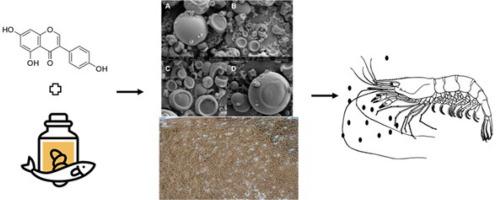Microcapsules carriers of phenolic extracts of Maclura tinctoria (L) D. Don ex steud with/without fish oil: potential additive in commercial aquafeeds
引用次数: 0
Abstract
The carrier potential of microencapsules of Maclura tinctoria phenolic extracts (BE) (Pat. # MX386653B) mixed with fish oil (FO) was determined. The spray dry process produced three different FO concentrations microcapsules: T1 = BEMIC; T2 = BEFO25 (BS+FO 25 mL l-1), and T3 = BEFO5 (BS + FO 50 mL l-1). The significantly highest Total phenol content (TPC), total flavonoids (TFC), condensed tannins (TTC), AA., and FRAP resulted in BEFO05 (253.35 mgEGA g-1, 98.63 EQ g-1, and 99.49 mgECA g-1, 47.55 ± 1.04 mgEGA mL-1, and 7.1 ± 0.1 mgEAA, respectively). The three powders showed adequate physical properties for juvenile shrimp aquafeeds with small size and circular morphology, low water activity and moisture content, high hygroscopicity, bulk, packing, Carr index, and Hausner ratio. The high dissolution and wetting times (56 and 66 min, respectively) allow the microcapsules to resist being submerged in water for a sufficient amount of time before being ingested, preserving the chemical properties of both the phenolic compounds and the fish oil.

加/不加鱼油的黄颡鱼酚类提取物微胶囊载体:潜在的商业水产饲料添加剂
黄花楸酚类提取物(BE)微胶囊的载体电位。# MX386653B)与鱼油(FO)混合。喷雾干燥制得三种不同浓度的FO微胶囊:T1 = BEMIC;T2 = BEFO25 (BS+FO 25 mL -1), T3 = BEFO5 (BS+FO 50 mL -1)。其中总酚(TPC)、总黄酮(TFC)、缩合单宁(TTC)、AA含量最高。, FRAP结果为BEFO05(分别为253.35 mgEGA g-1、98.63 EQ g-1、99.49 mgEGA g-1、47.55±1.04 mgEGA mL-1、7.1±0.1 mgEAA)。这三种粉末具有体积小、形状圆、水活度低、含水率低、吸湿性、体积、包装、卡尔指数和豪斯纳比高的特点。高溶解和湿润时间(分别为56分钟和66分钟)使微胶囊在被摄入之前能够抵抗在水中浸泡足够长的时间,从而保留了酚类化合物和鱼油的化学性质。
本文章由计算机程序翻译,如有差异,请以英文原文为准。
求助全文
约1分钟内获得全文
求助全文
来源期刊

Food chemistry advances
Analytical Chemistry, Organic Chemistry, Chemistry (General), Molecular Biology
CiteScore
1.90
自引率
0.00%
发文量
0
审稿时长
99 days
 求助内容:
求助内容: 应助结果提醒方式:
应助结果提醒方式:


